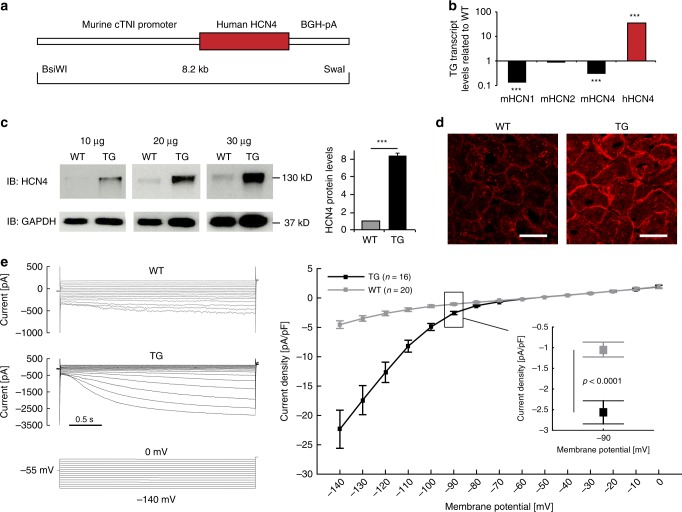Fig. 1.
Generation and characterization of transgenic HCN4tg/wt mice. a The transgene carries a 4.3 kb promoter fragment of the murine cTnI gene (cTnI) fused to the human HCN4 cDNA and the bovine growth hormone gene poly A signal (BGH-pA). b Profiling of the endogenous murine HCN1 (mHCN1), HCN2 (mHCN2), HCN4 (mHCN4), and transgenic human HCN4 (hHCN4) transcripts in the ventricular myocardium of 2-month-old HCN4tg/wt mice measured by quantitative real-time PCR, (qRT-PCR). Wild type = 1.0 (n = 6 animals; ***P < 0.001; unpaired t-test). c Western blot and quantitative analysis of HCN4 protein in the ventricular myocardium of HCN4tg/wt transgenic and wild type mice, normalized to glyceraldehyde 3-phosphate dehydrogenase (GAPDH) for control of protein loading. For comparison samples with different protein load (10, 20, 30 µg) are shown (n = 6 animals/groups; *P < 0.05, **P < 0.01, ***P < 0.001; unpaired t-test). d Immunohistochemistry for HCN4 (red) in ventricular myocardium of wild type (left) and transgene (right) mice. Scale bars 20 μm. Representative If currents (e) and current-voltage relationship (f) recorded from ventricular cardiomyocytes isolated from HCN4tg/wt and wild type mice (n = 20 cells from six wild type mice and n = 16 cells from five HCN4tg/wt mice; *P < 0.05, **P < 0.01, ***P < 0.001; unpaired t-test). Data are expressed as mean ± s.e.m. Source data are provided as a Source data file

